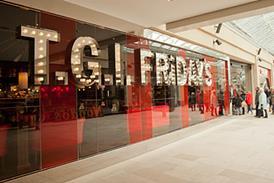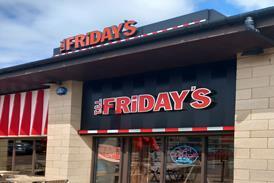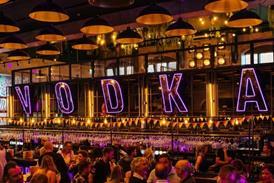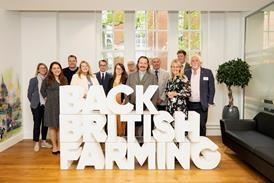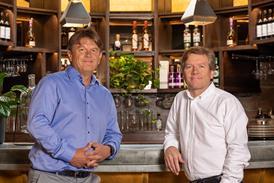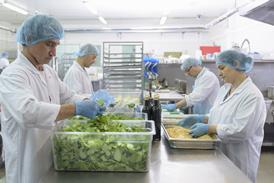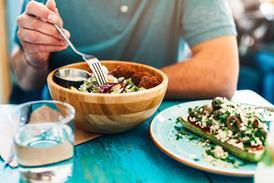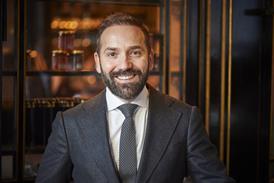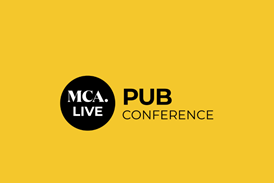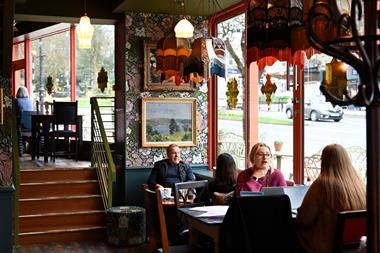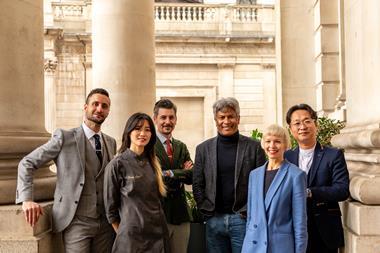His street food markets will attract more than one million visitors this year and his latest business, London Union, is backed by Jamie and Nigella. Now, as Stefan Chomka discovers, Jonathan Downey has his sights on creating the world’s best food and drink market.
Pass by Dinerama in Shoreditch early on in the week and you would be excused for mistaking it for yet another ramshackle and deserted scrap of land in the area, the type that is gradually being razed to the ground to make way for shiny new office blocks and luxury hotels as part of east London’s ‘regeneration’. With its scruffy metal shutter pulled down and with razor wire crawling atop the high walls, it has the appearance of a maximum security prison rather than a street-food market. The onlyhint that the space is anything but home to a rabble of inmates is a rather drab poster of some food and drink and an unlit neon sign that looks like it’s been pinched from the set of an 1980s high school movie.
Yet at 9pm on a Thursday it’s a different story; Dinerama comes alive. The 1,000 capacity venue, now self-enclosed after theinstallation of a roof for winter, is a throbbing mass of people, food, music, beer, cocktails, barbecue smoke and laughter. Or as Jonathan Downey, the founder of Street Feast and its parent company London Union, which runs the market, describes it – “vibes”. Dinerama is a ragtag affair of corrugated iron, graffiti and tin drums, as one might expet from a collective of disparate street-food traders bundled together within a semi-permanent structure in east London.
Stalls including Duck ’n’ Roll, Smokestak, Cheeky Italian and Baba G’s sit cheek by jowl, often separated by little more than a scruffy bit of MDF, with a long metal table and bolted down stools bisecting the ground floor space. As you wander round, however, it reveals itself to be a rabbit warren of distinct and stylish areas with an upstairs wine bar (Winerama), alpine log cabin and a 1950s-inspired British cocktail lounge.
It might all feel very Shoreditch, but London Union’s food markets are operating simultaneously across other parts of the capital, and in some less-than-obvious locations. This spring, Street Feast reopens in Dalston Yard while Model Market will make a return to Lewisham in the next few months. Hawker House, the 25,000sq ft behemoth in Canada Water has also just reopened after a short hiatus. Between them, more than 300,000 people walked through their doors in five months last year and 1.5 million people are expected to pay a visit in 2016.
The early days of Street Feast
With four markets in operation and more on the cards, Downey, or JD as he is more commonly known, has helped transform London’s burgeoning, but fragmented, street food scene into a slick and cohesive network of operators, and all in an incredibly short period of time. Today, Street Feastworks with a collective of around 60 street-food traders, many of which now operate multiple sites thanks to the markets.
Downey a well-known bar operator and former restaurateur, initially got involved with Street Feast through events promoter Dominic Cools-Lartigue. Cools-Lartigue had set up the original Street Feast on London’s Brick Lane before it moved to Dalston Yard and came to Downey in early 2013 to help breathe new life into it. Downey already had experience of the street-food scene from as early as 2011 when he ran events called ‘Tweat-ups’, which used Twitter to mobilise groups of people to visit a chosen food trader with the promise of booze, and so relished the opportunity to be more at the front line of the street-food movement.
Thus followed the creation of Merchant Yard in Haggerston that year, where Downey secured chef Ben Spalding to create a sit-down menu and made a gin bar out of a vacant building, laying down the blueprint for how subsequent markets would look.
“I brought a bit more drinks professionalism to the mix and got a few more traders on board and it just happened,” he says. “It was an accumulation of what I enjoyed doing in my 20s and what I learnt in 18 years in hospitality, not least running VIP areas at music festivals.”
It was at Haggerston that the pair realised there was an appetite for space that combined London’s best street food with bars. Downey recalls the moment they knew they had struck gold. “Dom was on his way there on a packed train and, when it got to Haggerston, everybody got off. That was the moment we knew we were doing something good.”
As the market grew and moved around, Downey became more and more involved in running all the bars as well as finding new traders and weeding out the ones that didn’t make the grade. “Looking back, there were some not very good traders,” he admits. “I wanted to make everything run better and be more profitable.”
‘Place making’ across the capital
The success of the Street Feast brand can be attributed to a number of factors. First, the markets are indeed profitable thanks to Downey’s knack for finding huge, prime London sites often with peppercorn rents thanks to their condition. The highest rent the company pays is £6 per sq ft, with it also having secured a 10-year lease at £5 per sq ft. One site is even rent free, with the landlord using the markets for what Downey calls ‘place making’ – letting him have it for free in the hope that it will bring new prospects to the area.
This has encouraged him to look at sites in London many might consider prohibitively expensive for an operation of such scale, with Downey constantly trawling Google Maps and speaking with landlords such as Transport for London, British Land and Land Securities to hunt down sites due for demolition or renovation but which would be perfect for short-term occupation.
“Whenlandlords see what we can do in five weeks with £100k they jump at theopportunity to work with us,” he says, adding that he’s turned down offers of sites in places as diverse as Margate and Cambridge. “There are places in London I’d never heard of, such as Loughborough Junction, where there are some great spaces. I’d never been to Lewisham in my life before I saw the Model Market site. It was a brave move but we knew we could build something great there.”
Another brave move was the huge Hawker House site in Canada Water that opened in October last year. A far cry from the grime and grunge of Shoreditch or Dalston, opening up in Canada Water has proven to be a watershed moment for the company in as much as it marks its acceptance by a more mainstream crowd.
“I was really concerned about Hawker House, but to have the opportunity to do something on that scale was seductive,” he admits. “We had 4,500 people through the door in two days so it proved to be a good move. It’s two stops from London Bridge and one from Bermondesy, which is cool, and it’s also on the overground, which means people can get there from Hackney and south-east London.”
The markets’ low rents and start-up costs mean the company’s return on capital employed is enviable. Dalston Yard cost just £90,000 to open, a figure that it recouped in just nine days of trading, while Dinerama cost £575,000, thanks to its multi-storey layers, and from mid June to the end of September already made back £445,000 of that. Dalston Yard is a year-on-year rolling lease; Dinerama has a five-year lease.
The company gets 75 per cent of its revenue through the bar takingsand 25 per cent from pitch fees, which sit at 10-15 per cent of turnover, and the door (a £3 entrance fee is charged after 7pm). “We run a high-margin business with a low staff cost, which is why it has been so profitable,” says Downey, adding that he expects Dinerama to turn over £1m this year.
“If anyone’s got a better return on capital in food and beverage, I’d love to know their secret.”
Downey also firmly believes that Lewisham’s Model Market is finally putting the south-east London borough on the radar.
“The only thing I think I can brag about, and I might beaccused of bragging about a few things, is that we’ve helped change the perception of Lewisham. It has a brilliant community of people who didn’t have anywhere cool to go. Everyone is always going on about how cool Brixton and Peckham are and we’ve helped make Lewisham cool. More things will happen there as a result.”
Indeed, the next cool thing will be another London Union-backed project. The company is working with long-term Street Feast trader Breddos Tacos for its first permanent restaurant, on the site of a former theatre in Lewisham. Called Pocho, it will be a large Californian/Mexican influenced diner. The neighbouring site, also owned by London Union, will be home to a new pizza concept from Polpo.
Nurturing top talent
Street Feast’s other key strength is the nurturing and building of talent, meaning that it doesn’t struggle to attract the capital’s top traders.
“They might be the joint best, but if you want the best gua bao you go to Yum Bun, the best taco you go to Breddos. There are five or six best burgers in London, such as MEAT liquor and Patty & Bun, but it’s hard to beat Bleecker St Burger (at Hawker House),” he says.
Moreover, Street Feast has provided a new trajectory for operators and chefs who might have initially started a food stall with the aim of getting a permanent site further down the line.
“An obvious step is to go from a stall to bricks and mortar, which is what Pizza Pilgrims, MEAT liquor and Pitt Cue have done, but for most people, that’s a really bad idea. I meet street food traders doing brilliant things, but that are not viable as permanent sites. It’s tough to make enough money to make it worthwhile. You work your arse off for three years and never get the return you deserve.”
Downey speaks from experience. He says he made around £100,000 from running Red Hook restaurant in Farringdon.
“Fuck that for a six-day-a-week operation. Unless you’re making £200,000, the business risk isn’t worth it.”
Street Feast, on the other hand, gives operators the option to go into semi-permanent spaces with less risk and higher margins.
“It’s a better business and a better lifestyle. You’re not working six days a week in a job you don’t like. Many chefs are working 70-hour weeks in a basement kitchen with no satisfaction, money or lifestyle. Most operators are passionate amateurs. I’d love more professional chefs to make the step. I’m surprised more haven’t made that life change.”
Downey reckons the best street-food operators can earn some serious money at Street Feast just from opening three days a week in the autumn and winter, and four in spring and summer.
“Some of the guys are doing £5,000 to £8,000 a week at Hawker House. The staff costs are super low, the property costs negligible and the return on that is pretty good. That’s good money in your pocket just for a two-day operation.”
He also believes the markets are helping sustain the capital’s street-food movement.
“Had Street Feast not come along and given [traders] this regular, high-income opportunity, some of these guys would have given up by now. And London would be all the poorer for it. It’s fucking hard work cooking in your kitchen, sticking food in the back of a car and driving to some shitty market where it might be raining. They all started out like that and paid their dues but are now in a better position.”
The man behind the bars
Since those early Haggerston days, Downey has become the recognisable face of Street Feast, and subsequently London Union, and has used his plain speaking and love of a good time to full advantage. His musings on Twitter via his @BigEater handle, whether bemoaning the parlous state of toast in some restaurants (#toastrage), railing at bloggers and PR spin or just demonstrating the vast amount of eating out he does each week, haven’t always endeared him to the restaurant crowd, but have marked him as someone who is pro fun and anti bullshit, which are, very much, the trademarks of his markets.
Followers of Downey will also be aware of his acerbic views of the current bar scene, something on which he is well placed to comment given his track record in the industry. Having worked for 10 years as a lawyer in the City then in Hong Kong and Abu Dhabi, Manchester-born Downey returned to London in 1996 with “a pile of ex-pat cash”. On buying a place to live in Old Street, he realised there were no places in which he wanted to drink at night, and so instead headed back to Manchester every fortnight to follow his beloved Manchester United and to end up in legendary nightclub The Haçienda.
Spotting a niche in London for a slice of ‘Madchester’s’ nightlife, he opened Match bar in Clerkenwell, followed by a second in the West End, and grew his bar group from there. Then, in 2001, on a cocktail safari to New York, he found himself in a newly opened bar called Milk & Honey talking to its founder Sasha Petraske. A drunken conversation that night eventually led to Downey opening a second Milk & Honey in Soho, operating it as a private members club and winning a number of awards in the process. The intervening years between those early days and now were eventful. Downey’s burgeoning bar group experienced a number of highs and lows, the nadir coming in 2010 when his Old Street bar Sosho burnt down. By the time he got involved with Street Feast Downey had opened around 20 restaurants and bars in London, Ibiza, Chamonix and Australia, but he has since closed most of them. Milk & Honey and Shoreditch bar Danger of Death remain the only two businesses he is involved in outside of London Union, although he is also an investor in Stevie Parle’s Dalston restaurant Rotorino.
Downey’s bar experience and also his seemingly instinctive understanding of space (he wanted to be an architect when he was young) has been pivotal to Street Feast’s success. The bar areas in Dinerama are distinct and stylish (or as much as they can be in a prison-chic building, anyway) without being pretentious. Moreover, they are designed with the drinker in mind, not the bartender.
It might seem a no-brainer to create convivial spaces that not only encourage drinking but also fun, but he believes people flock to the markets not just for the food but the atmosphere the bars create, something he says is lacking in many aspiring drinking places.
“I fucking hate not only the London bar scene but the scene globally – obviously with some strong exceptions,” is his response when asked where he does like to drink (he later name checks Happiness Forgets in Hoxton and Original Sin in Stoke Newington when pressed on these exceptions).
“The biggest problem with the London bar scene is that no one will say anything bad about anybody. Restaurants are critiqued all the time by know-nothing bloggers and professional critics and it keeps it in check. In the bar business, this doesn’t exist.
“The lack of hospitality can hit you in the face with some places. There’s a vibe vacuum. Even in a place I like to sit, bartenders seem reluctant to give me a drink – maybe it’s because they know me and don’t like me. Bartenders today are so self-absorbed. Great drinks plus a great time equals a great bar, but these guys think ‘my great drinks equals a great bar’. That’s not the fucking case.”
The world in Union
Downey’s vitriol for the UK bar scene is matched (almost) by his disappointment that the London food scene still doesn’t get the credit he believes it deserves. This is where London Union comes into play. The business, founded by Downey and Leon co-founder Henry Dimbleby in June last year, recently raised £2.5m on crowdfunding platform Seedrs to not only build the current network of Street Feast markets but to create one super food and drink market to rival Borough Market. London Union had initially sought to raise £3.5m, and Downey says there is a lot of interest from private funds meaning it will eventually meet, and possibly exceed, this target.
“I’m incredibly ambitious and so is Henry to create the world’s greatest food market in London,” he says. “I travel a lot and appreciate food in LA, New York, Berlin, Copenhagen, and, even though London is the best place in the world to eat, it doesn’t have that reputation internationally.
“I’m sick of hearing what an amazing market La Boqueria in Barcelona is or what amazing food you get in San Sebastian. Our produce is amazing and I want to bring it all into one place and showcase British food, farmers, producers and philosophy. I want to get Pete Wells (the New York Times restaurant critic) over here and tell me the brisket at Smokestak is as good as Franklin Barbecue in Austin. That really matters to me.”
The market will be open seven days a week from morning until evening with coffee makers, bakers, butchers, distillers and fresh fruit and veg stalls sitting alongside numerous restaurant counters to create not only a food market, but a place in which to eat and drink unlike anything seen on these shores. The pair have their eyes on Smithfield Market for the location, and are currently in talks with its new owner, the City of London, about a deal.
“From a space perspective, Borough Market is disparate whereas Smithfield is a giant purpose built Victorian marketplace. People will walk in to it and think ‘wow’, whereas at Borough you walk around a network of streets. It’s the best outcome for the site as it reverts it to its original use and will create an attraction in a part of London that is currently lacking.”
London Union’s masterstroke, however, is its board of founder investors, which includes high-profile names from the world of restaurants and the media, such as Soho House Group’s Nick Jones, Nigella Lawson, Jamie Oliver, Yotam Ottolenghi, Giles Coren and Rosie Boycott. Together they make a compelling case for any landlord to back the company.
It’s an impressive roster of people to acquire, even for someone as well connected as Downey, who counts Gary Lineker and broadcaster Richard Bacon as close friends, but it was the idea and his unswerving belief in the project that really swung it.
“We told them our vision for the food market and they completely got it – Jamie came back immediately with a yes.”
Out of 21 people asked, 20 agreed. And the naysayer? Anthony Bourdain (one possible reason for this is that Bourdain is reportedly opening what will be New York’s largest food hall next year inside Chelsea’s Pier 57 development).
So far, Downey says he has asked nothing from the board but, when a site is confirmed, he’ll likely come knocking to secure its expertise. Other founder investors, including Bill Granger, Dishoom’s Shamil Thakrar, José Pizarro and Richard Turner are likely to have operations there, possibly bespoke to the market.
“Everyone we’ve asked is in for a good reason.”
It’s still early days and how much the market will cost will depend on whether the landlord spends money on the building and passes this cost on as a higher rent, or London Union takes the build on itself and pays a lower rent. Eitherway, Downey projects it will cost ‘a few million pounds’ but that it will also, come 2017 when it opens, attract five million visitors a year, making it one of the most visited places in London.
Having one of the capital’s top tourist attractions isn’t enough. London Union plans to have around 12 local markets in total, housing more than 200 trader pitches and 100 bars, with areas such as Ealing and Silvertown Quays on the radar. It is even optimistic about having a floating market on the Thames.
Its ambitions aren’t confined to London, either. While Downey says he could operate smaller local markets in places such as Manchester, Bristol and Leeds, they aren’t as appealing as crossing The Pond and going to Philadelphia or Detroit. The first non-UK market looks set to open in Amsterdam, however, and will likely be a mix of Dutch and UK traders. After that, there seems little to suggest that the Street Feast brand won’t be cropping up in prime places across the globe in the not too distant future.
Dressed in boots and his trademark plain black jumper (it’s Paul Smith, he says, but it could as easily be Primark), Downey looks nothing like the influential giant he is slowly becoming on the food scene. But, like Dinerama on a cold morning in January, appearances can be deceptive.


